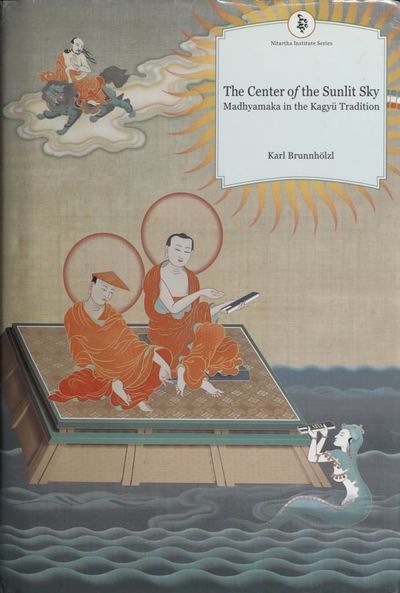No edit summary |
No edit summary |
||
| (5 intermediate revisions by 2 users not shown) | |||
| Line 6: | Line 6: | ||
|PersonPage=Pawo Rinpoche, 2nd | |PersonPage=Pawo Rinpoche, 2nd | ||
|PersonName=Second Pawo Tsuklak Trengwa | |PersonName=Second Pawo Tsuklak Trengwa | ||
}} | |||
|FullTextRead=No | |FullTextRead=No | ||
|BookToc=* {{i|Acknowledgments|11}} | |BookToc=* {{i|Acknowledgments|11}} | ||
| Line 12: | Line 12: | ||
* {{i|Preface| 17}} | * {{i|Preface| 17}} | ||
* {{i|Introduction| 25}} | * {{i|Introduction| 25}} | ||
* {{i|'''PART ONE: The General Presentation of Madyamaka in the Kagyü Tradition'''| 45}} | * {{i|'''PART ONE: The General Presentation of Madyamaka in the Kagyü Tradition'''| 45}} | ||
* {{i|'''1. The Transmission of Madhyamaka from India to Tibet and Its Relation to Vajrayāna and Mahāmudrā'''| 47}} | |||
* {{i|'''1. The Transmission of Madhyamaka from India to Tibet and Its Relation to<br>Vajrayāna and Mahāmudrā'''| 47}} | |||
* {{i|'''2 The Middle from Beginning to End'''| 69}} | * {{i|'''2 The Middle from Beginning to End'''| 69}} | ||
** {{i|Madyamaka Ground| 72}} | ** {{i|Madyamaka Ground| 72}} | ||
| Line 24: | Line 27: | ||
**** {{i|Seeming Divisions of the Seeming| 94}} | **** {{i|Seeming Divisions of the Seeming| 94}} | ||
**** {{i|Dividing Space: Divisions of the Ultimate| 99}} | **** {{i|Dividing Space: Divisions of the Ultimate| 99}} | ||
**** {{i|A Critical Analysis of Some Other Tibetan Views on the Two Realities in Centrism|101}} | **** {{i|A Critical Analysis of Some Other Tibetan Views on the Two<br>Realities in Centrism|101}} | ||
**** {{i|The Definite Number of Two Realities and the Purpose of Understanding Them|105}} | **** {{i|The Definite Number of Two Realities and the Purpose of<br>Understanding Them|105}} | ||
*** {{i|The Emptiness of Emptiness| 110}} | *** {{i|The Emptiness of Emptiness| 110}} | ||
**** {{i|Freedom Is the Nature of Not Having a Nature| 110}} | **** {{i|Freedom Is the Nature of Not Having a Nature| 110}} | ||
| Line 47: | Line 50: | ||
**** {{i|The Status of Valid Cognition in Centrism| 199}} | **** {{i|The Status of Valid Cognition in Centrism| 199}} | ||
**** {{i|Do Centrists Have a Thesis or Position?|218}} | **** {{i|Do Centrists Have a Thesis or Position?|218}} | ||
**** {{i|Illusory Lions Killing Illusory Elephants: Empty Reasonings for Liberation|231}} | **** {{i|Illusory Lions Killing Illusory Elephants: Empty Reasonings for<br>Liberation|231}} | ||
***** {{i|Some Essential Points of Centrist Reasoning|231}} | ***** {{i|Some Essential Points of Centrist Reasoning|231}} | ||
***** {{i|Disillusionment with Phenomenal Identity| 235}} | ***** {{i|Disillusionment with Phenomenal Identity| 235}} | ||
| Line 64: | Line 67: | ||
*** {{i|Madhyamaka Conduct| 321}} | *** {{i|Madhyamaka Conduct| 321}} | ||
** {{i|Madhyamaka Fruition| 323}} | ** {{i|Madhyamaka Fruition| 323}} | ||
* {{i|'''3 The Distinction between Autonomists and Consequentialists'''| 333}} | * {{i|'''3 The Distinction between Autonomists and Consequentialists'''| 333}} | ||
** {{i|Classifications of Centrism in India and Tibet| 333}} | ** {{i|Classifications of Centrism in India and Tibet| 333}} | ||
** {{i|Refutation of Mistaken Assumptions about Autonomists and Consequentialists |341}} | ** {{i|Refutation of Mistaken Assumptions about Autonomists and<br>Consequentialists |341}} | ||
** {{i|The Actual Distinction between Autonomists and Consequentialists| 360}} | ** {{i|The Actual Distinction between Autonomists and Consequentialists| 360}} | ||
** {{i|How the Distinction between Autonomists and Consequentialists by Later Tibetans Is a Novelty |373}} | ** {{i|How the Distinction between Autonomists and Consequentialists by Later Tibetans Is a Novelty |373}} | ||
| Line 72: | Line 76: | ||
** {{i|Do Hearers and Solitary Realizers Realize Emptiness?| 421}} | ** {{i|Do Hearers and Solitary Realizers Realize Emptiness?| 421}} | ||
** {{i|Conclusion |438}} | ** {{i|Conclusion |438}} | ||
* {{i|'''4 Is There Such a Thing as Shentong-Madhyamaka?'''| 445}} | * {{i|'''4 Is There Such a Thing as Shentong-Madhyamaka?'''| 445}} | ||
** {{i|The Yogācāra System in General|457}} | ** {{i|The Yogācāra System in General|457}} | ||
** {{i|The System of the Lineage of Vast Activity |460}} | ** {{i|The System of the Lineage of Vast Activity |460}} | ||
** {{i|The Treatment of Yogācāra and the Rangtong-Shentong Controversy in<br>Tibet |500}} | ** {{i|The Treatment of Yogācāra and the Rangtong-Shentong Controversy in<br>Tibet |500}} | ||
** {{i|The Single Final Intention of the Two Philosophical Systems of the Great Vehicle |515}} | ** {{i|The Single Final Intention of the Two Philosophical Systems of the Great<br>Vehicle |515}} | ||
* {{i|'''5 The Distinction between Expedient and Definitive Meaning'''| 527}} | * {{i|'''5 The Distinction between Expedient and Definitive Meaning'''| 527}} | ||
* {{i|'''6 An Outline of Some Major Differences between Mikyö Dorje's and<br>Tsongkhapa's Interpretations of Centrism'''| 553}} | * {{i|'''6 An Outline of Some Major Differences between Mikyö Dorje's and<br>Tsongkhapa's Interpretations of Centrism'''| 553}} | ||
* {{i|'''PART TWO: The Bodhicaryāvatāra and Pawo Tsugla Trengwa'''| 599}} | * {{i|'''PART TWO: The Bodhicaryāvatāra and Pawo Tsugla Trengwa'''| 599}} | ||
* {{i|'''7 Some Remarks on the Bodhicaryāvatāra and Pawo Rinpoche's Commentary'''|601}} | * {{i|'''7 Some Remarks on the Bodhicaryāvatāra and Pawo Rinpoche's Commentary'''|601}} | ||
* {{i|'''8 The Ninth Chapter of Pawo Rinpoche's Commentary on The Entrance to the Bodhisattva's Way of Life'''| 617}} | * {{i|'''8 The Ninth Chapter of Pawo Rinpoche's Commentary on The Entrance to the Bodhisattva's Way of Life'''| 617}} | ||
* {{i|Appendix I: ''A Short Biography of the Second Pawo Rinpoche Tsugla Trengwa'' |791}} | * {{i|Appendix I: ''A Short Biography of the Second Pawo Rinpoche Tsugla Trengwa'' |791}} | ||
* {{i|Appendix II: ''Non-Buddhist Indian Schools'' |794}} | * {{i|Appendix II: ''Non-Buddhist Indian Schools'' |794}} | ||
| Line 93: | Line 104: | ||
|QuotesTabContent={{GetBookQuotes}} | |QuotesTabContent={{GetBookQuotes}} | ||
|PostStatus=Needs Final Review | |PostStatus=Needs Final Review | ||
|StopPersonRedirects=No | |||
}} | }} | ||
Latest revision as of 16:10, 17 September 2020
Madhyamaka is a potent and universally accessible means of calming out suffering and awakening to our innate wisdom. The Center of the Sunlit Sky artfully rescues this brilliant teaching from its unwarranted reputation for intellectual opacity and reinstates it as a supremely practical toolkit for everyday living. The aim of this book is to take Mahyamaka out of the purely intellectual corner into which it–unjustly–gets boxed. It is an attempt to show how Madhyamaka actually addresses and works with all of our experiences in life.
The book follows the original Indian sources as well as the standard commentaries on Madhyamaka in the Kagyü School of Tibetan Buddhism. At the same time, these materials are adapted for a contemporary audience, combining the familiar sharpness of Madhyamaka reasonings (launching a massive assault on our cherished belief systems) with exploring the practical relevance of the Madhyamaka way of mind training.
Part One of the book, "The General Presentation of Madhyamaka in the Kagyü Tradition," provides an overview of the transmission of Madhyamaka from India to Tibet and its relation to Vajrayāna and Mahāmudrā, followed by a general presentation of Madhyamaka in terms of ground, path, and fruition. Further chapters are devoted to the Autonomist-Consequentialist distinction, the controversial issue of "Shentong-Madhyamaka," the distinction between expedient and definitive meaning, and a penetrating presentation of the major differences between the Eight Karmapa's and Tsongkhapa's interpretations of Madhyamaka.
Part Two consists of a brief introduction to the Bodhicaryāvatāra and a translation of the Second Pawo Rinpoche's commentary on its ninth chapter (on knowledge).
(Source: book jacket)
| Citation | Brunnhölzl, Karl. The Center of the Sunlit Sky: Madhyamaka in the Kagyü Tradition. Including a translation of Pawo Rinpoche's commentary on the knowledge section of Śāntideva's The Entrance to the Bodhisattva’s Way of Life (Bodhicaryāvatāra). Nitartha Institute Series. Ithaca, NY: Snow Lion Publications, 2004. |
|---|---|



